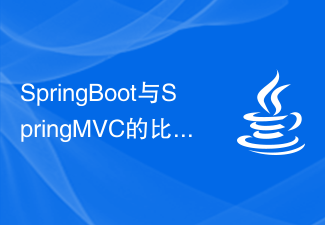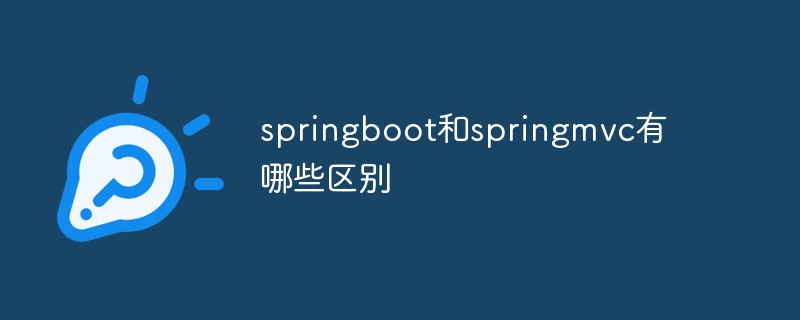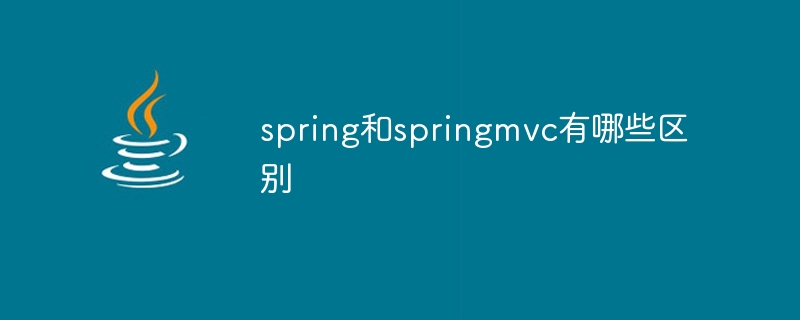
Common SpringMVC annotations
1, @Controller
@Controller is used to mark a class. The class marked with it is a SpringMVC Controller object. The dispatch processor will scan the method of the annotated class and detect whether the method is annotated with @RequestMapping. @Controller just defines a controller class, and the method annotated with @RequestMapping is the processor that actually handles the request.
The @Controller mark on a class cannot truly say that it is a controller class of SpringMVC, because Spring does not recognize it at this time. At this time, we need to hand over this controller class to Spring for management. There are two ways to manage:
<!--方式一--> <bean class="com.cqvie.handler.HelloWorld"/> <!--方式二--> < context:component-scan base-package = "com.cqvie" /> <!-- 路径写到controller的上一层 -->
In addition, Controller will not directly depend on HttpServletRequest and HttpServletResponse and other HttpServlet objects, they can be flexibly obtained through the method parameters of Controller. In order to have a preliminary impression of the Controller, let’s define a simple Controller:
package com.cqvie.handler;
import org.springframework.stereotype.Controller;
@Controller
public class HelloWorld {
@RequestMapping("/helloworld")
public String sayHello() {
System.out.println("Hello World!");
return "success";
}
}2, @RequestMapping
RequestMapping is a Annotations used to handle request address mapping can be used on classes or methods. Used on a class, it means that all methods in the class that respond to requests use this address as the parent path.
The return value will be parsed into the actual physical view through the view parser. For the InternalResourceViewResolver view parser, the following parsing will be done:
The actual physical view is obtained through prefix returnVal suffix. , and then do the forwarding operation;
<!-- 配置视图解析器:如何把 handler 方法返回值解析为实际的物理视图 -->
<bean class="org.springframework.web.servlet.view.InternalResourceViewResolver">
<property name="prefix" value="/WEB-INF/views/"></property>
<property name="suffix" value=".jsp"></property>
</bean>The RequestMapping annotation has six attributes:
1), value
value: specifies the actual address of the request;
2), method;
method: Specify the method type of the request, GET, POST, PUT, DELETE, etc., explained after @PathVariable in the following example:
/**
* Rest 风格的 URL(以 CRUD 为例):
* 新增:/order POST
* 修改:/order/1 PUT
* 获取:/order/1 GET
* 删除:/order/1 DELETE
* @param id
* @return
*/
@RequestMapping(value = "/testRestPut/{id}", method = RequestMethod.PUT)
public String testRestPut(@PathVariable int id) {
System.out.println("testRestPut:" + id);
return SUCCESS;
}
@RequestMapping(value = "/testRestDelete/{id}", method = RequestMethod.DELETE)
public String testRestDelete(@PathVariable int id) {
System.out.println("testRestDelete:" + id);
return SUCCESS;
}
@RequestMapping(value = "/testRestPost/{id}", method = RequestMethod.POST)
public String testRestPost(@PathVariable int id) {
System.out.println("testRestPost:" + id);
return SUCCESS;
}
@RequestMapping("/testRestGet")
public String testRestGet() {
System.out.println("testRestGet");
return SUCCESS;
}3), consumes
consumes: Specify the submission content type (Content-Type) for processing the request, such as application/json, text/html;
4), produces
produces : Specify the content type to be returned. It will be returned only if the (Accept) type in the request header contains the specified type;
5), params
params: The specified request must contain certain parameter values before this method can process it.
6), headers
headers: The specified request must contain certain specified header values in order for this method to process the request. Ant path of
@RequestMapping("/helloword/?/aa"), matching character:
● ?: Match one character of the file name
● *: Match all characters of the file name
● **: Match multi-layer paths
@RequestMapping("/testPojo") POJO class usage:
@RequestMapping("/testPojo")
public String testPojo(User user) {
System.out.println("testPojo:" + user);
return "success";
}
@RequestMapping("/testPojo") Map用法:
@RequestMapping("/testMap")
public String testMap(Map<String, Object> map) {
map.put("names", Arrays.asList("Tomcat", "Eclipse", "JavaEE"));
return "success";
}
@RequestMapping("/testPojo") ModelAndView用法:
@RequestMapping("/testModelAndView")
public ModelAndView testModelAndView() {
String viewName = SUCCESS;
ModelAndView modelAndView = new ModelAndView(viewName);
modelAndView.addObject("time", new Date());
return modelAndView;
}3. @Resource and @Autowired
@Resource and @Autowired are both used for bean injection. In fact, @Resource is not an annotation of Spring. The package is javax.annotation.Resource and needs to be imported, but Spring supports the injection of this annotation.
1), common points
Both can be written on fields and setter methods. If both are written on the fields, then there is no need to write setter methods.
2) Differences
(1)@Autowired
@Autowired annotation provided for Spring, you need to import the package org.springframework.beans.factory. annotation.Autowired; only injected according to byType.
public class HelloWorld{
// 下面两种@Autowired只要使用一种即可
@Autowired
private UserDao userDao; // 用于字段上
@Autowired
public void setUserDao(UserDao userDao) { // 用于属性的方法上
this.userDao = userDao;
}
}@Autowired annotation assembles dependent objects according to type (byType). By default, it requires that the dependent object must exist. If null values are allowed, its required attribute can be set to false. If we want to assemble by name (byName), we can use it in conjunction with the @Qualifier annotation. As follows:
public class HelloWorld{
@Autowired
@Qualifier("userDao")
private UserDao userDao;
}(2) @Resource
@Resource is automatically injected by ByName by default, provided by J2EE, and needs to import the package javax.annotation.Resource. @Resource has two important attributes: name and type, and Spring resolves the name attribute of the @Resource annotation to the name of the bean, and the type attribute resolves to the type of the bean. Therefore, if the name attribute is used, the byName automatic injection strategy is used, and when the type attribute is used, the byType automatic injection strategy is used. If neither the name nor the type attribute is specified, the byName automatic injection strategy will be used through the reflection mechanism.
public class HelloWorld{
// 下面两种@Resource只要使用一种即可
@Resource(name="userDao")
private UserDao userDao; // 用于字段上
@Resource(name="userDao")
public void setUserDao(UserDao userDao) { // 用于属性的setter方法上
this.userDao = userDao;
}
}Note: It is best to put @Resource on the setter method, because this is more in line with object-oriented thinking, and operates properties through set and get instead of directly operating properties.
4, @PathVariable
is used to map the template variables in the request URL to the parameters of the function processing method, that is, take out the uri template variables as parameters. Such as:
@Controller
public class TestController {
@RequestMapping(value="/user/{userId}/roles/{roleId}",method = RequestMethod.GET)
public String getLogin(@PathVariable("userId") String userId,
@PathVariable("roleId") String roleId){
System.out.println("User Id : " + userId);
System.out.println("Role Id : " + roleId);
return "hello";
}
@RequestMapping(value="/product/{productId}",method = RequestMethod.GET)
public String getProduct(@PathVariable("productId") String productId){
System.out.println("Product Id : " + productId);
return "hello";
}
@RequestMapping(value="/javabeat/{regexp1:[a-z-]+}",
method = RequestMethod.GET)
public String getRegExp(@PathVariable("regexp1") String regexp1){
System.out.println("URI Part 1 : " + regexp1);
return "hello";
}
}5, @CookieValue
Function: Used to obtain the value in Cookie;
Parameter: value :Parameter name required: Whether it is required defaultValue: Default value
Use case:
/**
* 获取 Session
* JSESSIONID=411A032E02A2594698F6E3F4458B9CE4
*/
@RequestMapping("/testCookieValue")
public String testCookieValue(@CookieValue("JSESSIONID") String sessionId) {
System.out.println("JSESSIONID = " + sessionId);
return "success";
}6、@RequestParam
@RequestParam用于将请求参数区数据映射到功能处理方法的参数上,用例:
/**
* @RequestParam("id") 带参映射
* @param id
* @return
*/
@RequestMapping("/testRequestParam")
public String testRequestParam(@RequestParam("id") int id) {
System.out.println("testRequestParam " + id);
return "success";
}7、@SessionAttributes
@SessionAttributes即将值放到session作用域中,写在class上面。
@SessionAttributes 除了可以通过属性名指定需要放到会话中的属性外(value 属性值),
还可以通过模型属性的对象类型指定哪些模型属性需要放到会话中(types 属性值),用例:
package com.cqvie.yjq;
import java.util.Map;
import org.springframework.stereotype.Controller;
import org.springframework.web.bind.annotation.RequestMapping;
import org.springframework.web.bind.annotation.SessionAttributes;
import com.cqvie.model.User;
@SessionAttributes(value = {"user"}, types = {String.class})
@RequestMapping("/springmvc")
@Controller
public class SessionAttributesTest {
/**
* @SessionAttributes
* 除了可以通过属性名指定需要放到会话中的属性外(value 属性值),
* 还可以通过模型属性的对象类型指定哪些模型属性需要放到会话中(types 属性值)。
* 注意: 该注解只能放在类的上面,不能放在方法上面
*
* @return
*/
@RequestMapping("/testSessionAttributes")
public String testSessionAttributes(Map<String, Object> map) {
User user = new User(1, "刘邦", "qwe", "123", "辽宁");
map.put("user", user);
map.put("school", "重庆");
return "success";
}
}8、@ModelAttribute
代表的是:该Controller的所有方法在调用前,先执行此@ModelAttribute方法,可用于注解和方法参数中,可以把这个@ModelAttribute特性,应用在BaseController当中,所有的Controller继承BaseController,即可实现在调用Controller时,先执行@ModelAttribute方法。
package com.cqvie.yjq;
import java.util.Map;
import org.springframework.stereotype.Controller;
import org.springframework.web.bind.annotation.ModelAttribute;
import org.springframework.web.bind.annotation.RequestMapping;
import org.springframework.web.bind.annotation.RequestParam;
import com.cqvie.model.User;
@Controller
@RequestMapping("/springmvc")
public class ModelAttributeTest {
private static final String SUCCESS = "success";
/**
* 1.有 @ModelAttribute 标记的方法,会在每个目标方法执行之前被 SpringMVC 调用
* 2.@ModelAttribute注解也可以修饰目标方法POJO类形的入参,其value的属性值有如下作用:
* 1)SpringMVC会使用value属性值在implicitModel中查找对应的对象,若存在则直接传入到目标方法的入参中
* 2)SpringMVC会以value为key,POJO类型的对象为value,存入的request中
*
* @param id
* @param map
*/
@ModelAttribute
public void getUser(@RequestParam(value = "id", required = false) int id,
Map<String, Object> map) {
//模拟数据库中获取对象
User user = new User(1, "刘邦", "123", "023", "重庆");
System.out.println("从数据库中获取一个对象:" + user);
map.put("abc", user);
}
/**
* 运行流程:
* 1.执行@ModelAttribute注解修饰的方法,从数据库中取出对象,把对象放入Map中,键为:user;
* 2.SpringMVC从Map中取出User对象,并把表单的请求参数赋值给该User对象的对应属性;
* 3.SpringMVC把上述对象传入目标方法的参数。
*
* 注意:在@ModelAttribute修饰的方法中,放入到Map时的键需要和目标方法入参类型的第一个字母小写的字符串一致
*
* @param user
* @return
*/
@RequestMapping("/testModelAttribute")
public String testModelAttribute(@ModelAttribute("abc") User user) {
System.out.println("修改:" + user);
return SUCCESS;
}
}9、@ResponseBody
作用: 该注解用于将Controller的方法返回的对象,通过适当的HttpMessageConverter转换为指定格式后,写入到Response对象的body数据区。
使用时机:返回的数据不是html标签的页面,而是其他某种格式的数据时(如json、xml等)使用;
本文来自php中文网,java教程栏目,欢迎学习!
The above is the detailed content of What are the commonly used annotations in springmvc?. For more information, please follow other related articles on the PHP Chinese website!
 SpringBoot与SpringMVC的比较及差别分析Dec 29, 2023 am 11:02 AM
SpringBoot与SpringMVC的比较及差别分析Dec 29, 2023 am 11:02 AMSpringBoot和SpringMVC都是Java开发中常用的框架,但它们之间有一些明显的差异。本文将探究这两个框架的特点和用途,并对它们的差异进行比较。首先,我们来了解一下SpringBoot。SpringBoot是由Pivotal团队开发的,它旨在简化基于Spring框架的应用程序的创建和部署。它提供了一种快速、轻量级的方式来构建独立的、可执行
 比较SpringBoot与SpringMVC的差异是什么?Dec 29, 2023 am 10:46 AM
比较SpringBoot与SpringMVC的差异是什么?Dec 29, 2023 am 10:46 AMSpringBoot与SpringMVC的不同之处在哪里?SpringBoot和SpringMVC是两个非常流行的Java开发框架,用于构建Web应用程序。尽管它们经常分别被使用,但它们之间的不同之处也是很明显的。首先,SpringBoot可以被看作是一个Spring框架的扩展或者增强版。它旨在简化Spring应用程序的初始化和配置过程,以帮助开发人
 SpringBoot与SpringMVC的区别是什么?Dec 29, 2023 pm 05:19 PM
SpringBoot与SpringMVC的区别是什么?Dec 29, 2023 pm 05:19 PMSpringBoot和SpringMVC是Java开发中常用的两个框架,它们都是由Spring框架所提供的,但在功能和使用方式上有着一些区别。本文将分别介绍SpringBoot和SpringMVC的特点和区别。一、SpringBoot的特点:简化配置:SpringBoot通过约定优于配置的原则,大大简化了项目的配置过程。它可以自动配置项目所需要的参数,开发人
 springboot和springmvc有哪些区别Jun 07, 2023 am 10:10 AM
springboot和springmvc有哪些区别Jun 07, 2023 am 10:10 AMspringboot和springmvc区别是:1、含义不同;2、配置不同;3、依赖项不同;4、开发时间不同;5、生产力不同;6、实现JAR打包功能的方式不同;7、是否提供批处理功能;8、作用不同;9、社区和文档支持不同;10、是否需要部署描述符。
 Java的SpringMVC拦截器怎么用May 13, 2023 pm 02:55 PM
Java的SpringMVC拦截器怎么用May 13, 2023 pm 02:55 PM拦截器(interceptor)的作用SpringMVC的拦截器类似于Servlet开发中的过滤器Filter,用于对处理器进行预处理和后处理。将拦截器按一定的顺序联结成一条链,这条链称为拦截器链(InterceptorChain)。在访问被拦截的方法或字段时,拦截器链中的拦截器就会按其之前定义的顺序被调用。拦截器也是AOP思想的具体实现。拦截器和过滤器区别区别过滤器(Filter)拦截器(Intercepter)使用范围是servlet规范中的一部分,任何JavaWeb工程都可以使用是Spri
 spring和springmvc有哪些区别Dec 29, 2023 pm 05:02 PM
spring和springmvc有哪些区别Dec 29, 2023 pm 05:02 PMspring和springmvc的区别:1、定位和功能;2、核心功能;3、应用领域;4、扩展性。详细介绍:1、定位和功能,Spring是一个综合性的应用程序开发框架,提供了依赖注入、面向切面编程、事务管理等功能,旨在简化企业级应用程序的开发,而Spring MVC是Spring框架中的一个模块,用于Web应用程序的开发,实现了MVC模式;2、核心功能等等。
 Java API 开发中使用 SpringMVC 进行 Web 服务处理Jun 17, 2023 pm 11:38 PM
Java API 开发中使用 SpringMVC 进行 Web 服务处理Jun 17, 2023 pm 11:38 PM随着互联网的发展,Web服务越来越普遍。JavaAPI作为一种应用编程接口,也在不断地推出新的版本来适应不同的应用场景。而SpringMVC作为一种流行的开源框架,能够帮助我们轻松地构建Web应用程序。本文将详细讲解在JavaAPI开发中,如何使用SpringMVC进行Web服务处理,包括配置SpringMVC、编写控制器、使用
 面试官:你说的SpringMVC的请求处理流程是网上抄的吧?Jul 26, 2023 pm 04:34 PM
面试官:你说的SpringMVC的请求处理流程是网上抄的吧?Jul 26, 2023 pm 04:34 PM本文主要从源码的阅读和调试的角度,整体的讲解了SpringMVC处理请求的整个流程,并且讲解了参数的绑定以及返回值的处理。相信大家看完后,结合自己的调试信息,会对SpringMVC的请求处理过程有一个更深入的理解。


Hot AI Tools

Undresser.AI Undress
AI-powered app for creating realistic nude photos

AI Clothes Remover
Online AI tool for removing clothes from photos.

Undress AI Tool
Undress images for free

Clothoff.io
AI clothes remover

AI Hentai Generator
Generate AI Hentai for free.

Hot Article

Hot Tools

SublimeText3 English version
Recommended: Win version, supports code prompts!

Safe Exam Browser
Safe Exam Browser is a secure browser environment for taking online exams securely. This software turns any computer into a secure workstation. It controls access to any utility and prevents students from using unauthorized resources.

Zend Studio 13.0.1
Powerful PHP integrated development environment

DVWA
Damn Vulnerable Web App (DVWA) is a PHP/MySQL web application that is very vulnerable. Its main goals are to be an aid for security professionals to test their skills and tools in a legal environment, to help web developers better understand the process of securing web applications, and to help teachers/students teach/learn in a classroom environment Web application security. The goal of DVWA is to practice some of the most common web vulnerabilities through a simple and straightforward interface, with varying degrees of difficulty. Please note that this software

mPDF
mPDF is a PHP library that can generate PDF files from UTF-8 encoded HTML. The original author, Ian Back, wrote mPDF to output PDF files "on the fly" from his website and handle different languages. It is slower than original scripts like HTML2FPDF and produces larger files when using Unicode fonts, but supports CSS styles etc. and has a lot of enhancements. Supports almost all languages, including RTL (Arabic and Hebrew) and CJK (Chinese, Japanese and Korean). Supports nested block-level elements (such as P, DIV),






